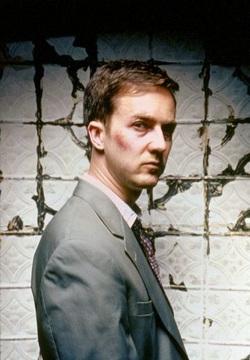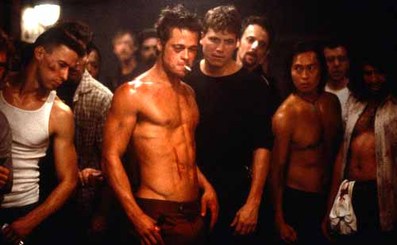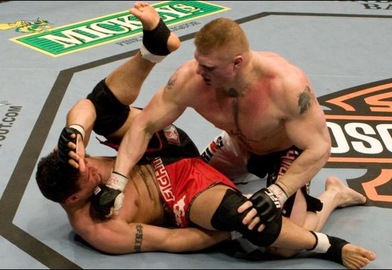Reflexive Adaptation: Real Life Fight Clubs

To
begin to explore the adaptation process of Fight Club that originated from
Chuck Palahniuk’s real life ‘fight’ encounter and his experiences with support
groups, to an award-winning novel, to an Oscar-nominated major motion picture
and eventually to where groups have people have adapted Fight Club into real
life, we need to define the term adaptation. According to Wikipedia, “Literary
Adaptation is the adapting of a literary source (e.g., novel, short story,
poem) to another genre or medium…” We have already analyzed the ‘How’ and
‘Why’ of the adaptation from novel to movie in this project and we are now
going to take an in-depth look at how people have interpreted and adapted the
central themes in the book and movie to their real life and how modern Mixed
Martial Arts may be the ultimate adaptation of Fight Club.
As we learned in lecture and the class blog, “reflexivity is a social phenomenon and theory that refers to a circular relationship between cause and effect. A reflexive relationship is bidirectional; with both the cause and the effect affecting one another in a situation that renders both functions causes and effects.” Chuck Palahniuk’s inspiration was born in the real life: After spending the weekend camping with friends (and fighting?) Palahniuk returned to work Monday morning with an obviously bruised face, and was taken aback when no one is the office asked where he got the gruesome bruises. Palahniuk also volunteered in a hospice where he served as an escort transporting some patients to various therapy groups . He found himself a spectator to these groups on a regular basis and feeling guilty that he was the only healthy person there. This is where he came up with the idea of “The Tourist” and the unnamed narrator who attends a plethora of therapy support groups ranging from groups for men with testicular cancer to groups for people with brain parasites in an attempt to alleviate his symptoms of insomnia. This eventually led to his radical form of psychotherapy – Fight Club.
As we learned in lecture and the class blog, “reflexivity is a social phenomenon and theory that refers to a circular relationship between cause and effect. A reflexive relationship is bidirectional; with both the cause and the effect affecting one another in a situation that renders both functions causes and effects.” Chuck Palahniuk’s inspiration was born in the real life: After spending the weekend camping with friends (and fighting?) Palahniuk returned to work Monday morning with an obviously bruised face, and was taken aback when no one is the office asked where he got the gruesome bruises. Palahniuk also volunteered in a hospice where he served as an escort transporting some patients to various therapy groups . He found himself a spectator to these groups on a regular basis and feeling guilty that he was the only healthy person there. This is where he came up with the idea of “The Tourist” and the unnamed narrator who attends a plethora of therapy support groups ranging from groups for men with testicular cancer to groups for people with brain parasites in an attempt to alleviate his symptoms of insomnia. This eventually led to his radical form of psychotherapy – Fight Club.

Needless to say Chuck Palahniuk wrote the
story Fight Club and published it on August 17th, 1996. Then several years later in 1999 when
the book was still not very popular, David Fincher the Director, with the help
of Jim Uhls the screenplay writer, adapted Chuck Palahniuk’s novel into a major
motion picture. The movie grossed around US$11,000,000
in revenue in the first weekend and its total gross domestic revenue was close
to US$38,000,000. These figures
may seem large but in comparison to their budget and revenue generated by
movies that were similar in nature.
Overall it was not the most successful book (in terms of copies sold)
and it did not achieve the projected revenues when the movie hit the box office. It was not until it was released onto
DVD, that a large ‘cult-like’ following began to form and the book and movie
also entered the main stream and became accepted to use in classrooms.
One of the central themes in the book is about how an entire generation of men in today’s society are “raised by women” who have not had to fight a war or suffer through a depression – we are just a capitalist consumer society who are obsessed with consumption. “Generations have been working in jobs they hate, just so they can buy what they don’t really need.” (Fight Club 110) The idea that men are biologically aggressive and violent in nature and that there needs to be a structured environment in which boys or men have an outlet to their building aggression. This ideology was accepted by boys and men all around the world and fight clubs began to emerge rapidly. These males had extended the adaptation process from real life to novel and movie and back to real life – this is a reflexive relationship where cause and effect in one form of adaptation has direct cause and effect on another form of adaptation. Schools around world including Canada began to have a serious issue of organized fight clubs happening during breaks between classes. This problem quickly became publicized and gained national media attention. Soon Fight Club was the centre of mainstream conversations and the centre of debates about extra-curricular activities to keep students busy during their breaks. The media projected this increase in popularity in fight clubs as a ‘cult-like’ following. Arguably this following has not yet dissipated, we believe strongly in the correlation between the ideas of Fight Club and modern Mixed Martial Arts and the Ultimate Fighting Championship (UFC).
(See these links for Fight Clubs that were started in Canadian Schools)
http://www.ctv.ca/CTVNews/TopStories/20081018/fight_club_081018/
http://www.ctv.ca/CTVNews/TopStories/20080411/high_school_fight_080411/
One of the central themes in the book is about how an entire generation of men in today’s society are “raised by women” who have not had to fight a war or suffer through a depression – we are just a capitalist consumer society who are obsessed with consumption. “Generations have been working in jobs they hate, just so they can buy what they don’t really need.” (Fight Club 110) The idea that men are biologically aggressive and violent in nature and that there needs to be a structured environment in which boys or men have an outlet to their building aggression. This ideology was accepted by boys and men all around the world and fight clubs began to emerge rapidly. These males had extended the adaptation process from real life to novel and movie and back to real life – this is a reflexive relationship where cause and effect in one form of adaptation has direct cause and effect on another form of adaptation. Schools around world including Canada began to have a serious issue of organized fight clubs happening during breaks between classes. This problem quickly became publicized and gained national media attention. Soon Fight Club was the centre of mainstream conversations and the centre of debates about extra-curricular activities to keep students busy during their breaks. The media projected this increase in popularity in fight clubs as a ‘cult-like’ following. Arguably this following has not yet dissipated, we believe strongly in the correlation between the ideas of Fight Club and modern Mixed Martial Arts and the Ultimate Fighting Championship (UFC).
(See these links for Fight Clubs that were started in Canadian Schools)
http://www.ctv.ca/CTVNews/TopStories/20081018/fight_club_081018/
http://www.ctv.ca/CTVNews/TopStories/20080411/high_school_fight_080411/

Click on image for UFC link
The UFC, which
now has an astronomical global following is essentially an adaptation from the
original Fight Club idea. The UFC
is essentially an organized Fight Club that has drawn global attention. In a UFC fight you are locked into an octagon-shaped
cage, you are fighting with relatively bare knuckles, with one other person and
the fight does not end until one person either taps out (gives up), gets
knocked out (referee ends the fight) or if times runs out. Is UFC the ultimate stage for
alleviation of male aggression or is it today’s violent culture going to
far? This question is widely
debated and both opinions can be argued. It is no surprise that UFC has had
such tremendous success because of advancements technology (in TV, movies, and
video games) and the ever-developing violent culture our society seems to love
to watch. David Fincher has been
quoted saying (in an interview with Film Comment in 1999) “We're
designed to be hunters and we're in a society of shopping. There's nothing to
kill anymore, there's nothing to fight, nothing to overcome, nothing to
explore. In that societal emasculation this everyman is created.” This is the fundamental theme in Chuck Palahniuk’s Fight Club
and effectively the reason behind the adaptation into a major motion picture
and inspiration to create real flight clubs. This is an example of a reflexive adaptive process.
~Thomas Meisner
~Thomas Meisner
Thomas Meisner, Eric Cheng, Juno Kim, Spencer Traher
English 227 UBC: Adaptations through Prose
Dr. Erika Paterson
English 227 UBC: Adaptations through Prose
Dr. Erika Paterson
